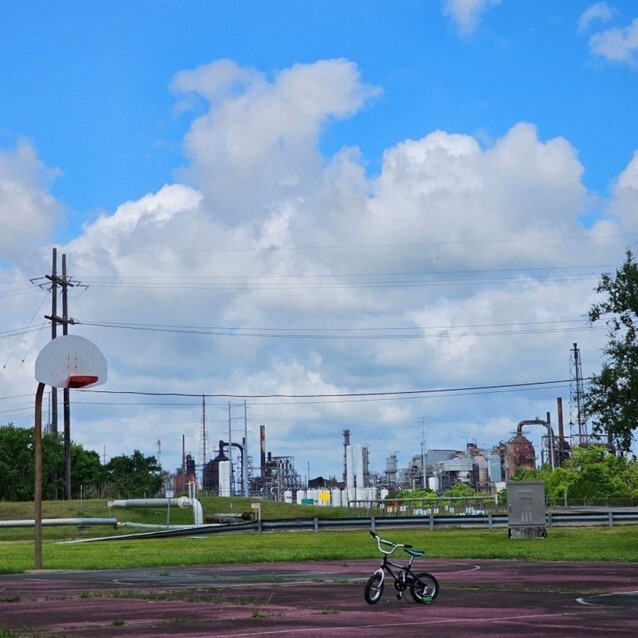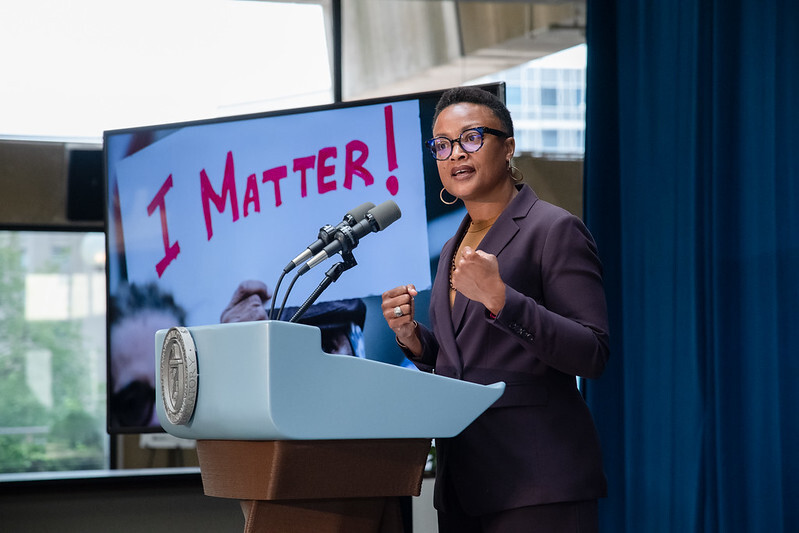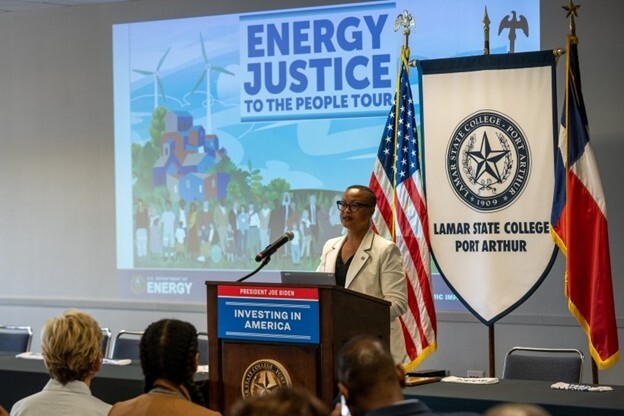| |

I joined the Biden-Harris Administration on Day One with a singular goal: To make the energy system work for all Americans. Over the past three and a half years, I have had the privilege of growing the size and budget of a little-known office I was asked to lead—the Office of Economic Impact and Diversity—and then renaming it the Office of Energy Justice and Equity. As the Director of the Office of Energy Justice and Equity, and the Secretarial Advisor on Equity, I have had the good fortune to be able to shine a spotlight on energy injustices and share my vision of what a just transition to clean energy entails.
I came into this journey as a scholar and policy wonk committed to the ideals of energy justice, but more than that, I came into this role as the daughter, granddaughter, and great-granddaughter of energy and environmental injustice. I leave this role humbled, stretched, and committed more than ever to creating a just and equitable energy system. I also leave behind a strong office dedicated to advancing justice and equity and working every day to bend the moral arc of the universe towards justice.
|
|
|

The Carver Terrace Park located of Port Arthur, TX. Photographer: Eugenia T. Gibbons
|
|
Three and a Half Years of Impact
Since joining the Biden-Harris Administration, I have witnessed a transformative shift in the way we talk about energy and the energy transition. From boardrooms to classrooms, from academic conferences to community forums, justice and equity have become a part of the debate. The question is no longer, “Should justice and equity be a part of the energy transition?” Rather, it is, “How can justice and equity be embedded in the energy system? What are the rules of engagement? What are the standards, and who should be at the table?” Further, “How do we measure our progress to advance justice and equity? What are our metrics to understand impact?”
I would like to think that these changes in the conversation are driven by the work that we are doing at the Department of Energy (DOE), work that is led by my Office.
When I look back to the day I received the call to serve in the winter of 2020, to lead the Justice40 Initiative for the Biden-Harris Administration, and to lead energy justice for a nation filled with so much injustice, it’s impossible not to reflect on how far this Office has come and how much change our team has delivered for the American people. Although the work is far from done, I am so proud of the ways in which our work has transformed the energy system.
Growing and Transforming the Office of Energy Justice and Equity
On June 7, 2022, I was confirmed by the Senate as the Director of the Office of Economic Impact and Diversity at DOE. But, since Day One of the Administration, I had been laying the groundwork to ensure that equity be embedded into DOE policies and practices. Upon confirmation, I could fully lean into the project of leading and transforming the Office. From the beginning, I had a feeling that executing EJE’s statutory mandate, rooted in energy justice; implementing President’s Biden’s landmark Executive Orders on justice, diversity, equity, inclusion and accessibility; and embedding equity into the DNA of DOE would take a lot of work. I wasn’t wrong!
Transforming the Office
At first glance, the most obvious changes I have made at the Department relate to our Office. When I arrived in 2021, the Office of Economic Impact and Diversity had just 37 staff members. That number has more than tripled and the office has changed its name to the Office of Energy Justice and Equity (EJE), better reflecting DOE’s commitment to communities that have historically been exploited by the nation’s fossil energy economy and the core mission of the office. But our accomplishments reach far deeper than the Office name and size. They relate to the ways in which the Department does business, including its hiring and retention practices, policies, and program design. Indeed, my office has championed shifts in the ways that the Department conducts its work. Our impact is historic.
|
|
Historic Action Plans to Advance Equity and DEIA
In September 2022, DOE released its first-ever Diversity, Equity, Inclusion, and Accessibility (DEIA) Strategy, which outlines Departmental actions to sustain an inclusive and accessible work environment by strengthening recruitment, retention, and promotion, while also removing barriers to advancement and development opportunities.
The principles of DEIA are fundamental to creating a society in which everyone can succeed. DEIA initiatives work to break down barriers that have traditionally excluded certain groups from opportunities. They ensure that everyone, regardless of their race, gender, disability, or socioeconomic status, has access to opportunities and can take part in the process.
As a part of our DEIA efforts, we have also turned inward to engage with DOE staff and contractors. We hosted the first-ever summit for Employee Resource Groups (ERG), the 2023 ERG Summit, as well as the DOE Accessibility Summit, which provided 12 training sessions over two months covering a broad range of topics concerning accessibility in the workplace. The Accessibility Summit kicked off Disability Awareness Month, which also featured an insightful and substantive event organized by DOE’s Office of Civil Rights and Equal Employment Opportunity (OCR EEO), a critical part of our team. Since January 2021, the OCR EEO has also curated dozens of Special Observance events that celebrate the richness of our diverse workforce and foster a deeper understanding of our colleagues’ and our own perspectives and experiences.

Director Baker provides remarks at Justice Week 2022.
In April 2022, DOE released the agency’s first-ever Equity Action Plan (EAP), which recognized and addressed foundational issues with how data is collected concerning underserved and underrepresented populations, and committed to removing barriers and building bridges to increase access to DOE funding opportunities for underserved and underrepresented populations.
The second EAP expanded on the successes of the first to continue the agency’s commitment to broadening access to resources and data collection, and also committed to establishing a Department-wide framework for Community Benefits Plans (CBP), a powerful tool to create good jobs, advance DEIA within the clean energy economy, and deliver much-needed economic and social benefits to communities housing DOE-funded projects.
The Department’s Equity Action Plans provide a structured approach to addressing systematic inequities. They offer detailed roadmaps for dismantling barriers to equity and fostering an environment in which everyone can thrive, regardless of their background or circumstances. They are also historic. Within this Administration, we have created an enduring architecture for DEIA and equity that will benefit millions of Americans.
Advancing Energy Justice and Energy Democracy
In support of the agency’s equity efforts, we also launched the Regional Energy Democracy Initiative (REDI) in the Gulf South region. REDI provides a critical tool for communities to realize community benefits. REDI also creates a framework for accountability. The program launched and began accepting applications in May 2024. Local organizations that wish to participate in shaping CBPs will receive a committed $5 million in DOE funding for technical assistance and capacity building to meet the needs of Texas and Louisiana communities housing DOE-funded climate investments. Plans are already in the works for additional REDI efforts in other regions around the nation, and REDI will serve as an enduring reminder of this Administration’s commitment to rooting industrial policy in the concepts and principles of energy justice and energy democracy.
The Department also tapped EJE to lead historic efforts to advance energy justice in underserved communities. In October 2023, EJE partnered with the Department of the Treasury and Internal Revenue Service to launch the historic Low-Income Communities Bonus Credit Program, a first-of-a-kind program that expands access to cost-saving clean energy projects in underserved communities through a groundbreaking tax incentive for clean energy projects. The program is designed to create opportunities for new market entrants in the clean energy sector and drive down the cost of energy for households hosting clean energy projects. It, too, is historic.
In addition to creating the architecture for equity within the agency, EJE has provided its own significant programmatic funding to community-based organizations to advance energy justice. A few examples from last year alone include REDI, as well as the nearly $1 million awarded to Puerto Rico to support community-led development of renewable energy systems through Resilience Hubs tailored to specific communities, and the more than $6 million granted to Black Owners of Solar Services (BOSS) to train underrepresented energy experts to apply for DOE funding and access DOE programs, benefits, services, and opportunities. The programs provide critical seed funding to prove concepts that can be brought to scale.
|
|
|
No matter how well we design our agency action plans and programs, our work must always connect to communities and their lived experiences. Since Day One, I have said that in order to create a more just and equitable energy system, the agency must engage with Americans who stand to benefit most from our programs. We have conducted dozens of webinars and hundreds of engagements with community members, advocates, and elected leaders. Thousands of people have also learned about Community Benefits Plans, the agency’s procurement and financial assistance opportunities, our equity strategy, and our approach to DEIA through events like DOE to the People, the Energy Justice to the People Roadshow, the Minority Business Enterprise (MBE) Connect Summit, and both our inaugural Energy Justice Week, in 2022, and last year’s Justice Week 2023: Equity Empowered. We have opened the door to the agency for those who, for far too long, have been excluded and forgotten.
|
|

Energy Secretary Jennifer Granholm and Director Shalanda Baker make a “house call” to visit Mrs. Shirley Watts Payne, a resident of the El Vista neighborhood of Port Arthur, TX.

Director of the Office of Energy Justice and Equity Shalanda H. Baker gives keynote address at Lamar State College Port Arthur in Port Arthur, TX.
|
|
|
The Justice 40 Initiative inspired me to join this historic Administration. In many ways, its goals and ideals gave life to all of this work: transforming the office, drafting plans on equity and DEIA, creating programs to reach the community level. Justice40 was my foundation. And it was my inspiration. Justice40 provided me with the aspiration and audacity to believe that fenceline and frontline communities might actually benefit from the energy transition. That we, as an agency charged with delivering climate solutions to communities through the spending of over $100 billion in taxpayer dollars, could create programs that center the hopes and dreams of communities, and require grantees to do things they’ve never done before with our Community Benefits Plan framework. That we would reckon with the structural racism and structural inequality embedded within the energy system. We did all that, and so much more.
None of the efforts outlined in this letter have been perfect, but they bring us closer to a more just world. They also lay the foundation for a future where all communities have the resources to flourish.
The last three and a half years have been the hardest of my life, but they have also allowed me to integrate the most sacred parts of my life with the academic and policy work I have been committed to for over a decade. This is a rare gift that few will receive in a lifetime.
These years and this role have allowed me to speak truth to power. They have allowed me to learn from elders, and to make new pathways for the next generation. Serving in this role has been the honor and privilege of a lifetime. I have, to borrow a phrase from sports, left it all on the field.
As we move forward, it is essential to support and expand the efforts outlined in this letter. It is essential to ensure that equity and justice are not just aspirational goals or considerations after the fact, but concrete strategies woven into programs and policies at their inception.
We are not going back to the way things were. We cannot. We must continue to fight for a future where everyone can succeed and prosper.
This will be my final newsletter as the Director of the Office of Energy Justice and Equity. I’m grateful for your support and encouragement as I have attempted to tackle the seemingly intractable problem of injustice within the nation’s energy system. We all have so much to be proud of, even as we acknowledge the remaining challenges to achieving an equitable energy system. Even as we acknowledge the challenges surely to come.
We made history together. But it is not enough. We must keep going. We must keep fighting.
Onward.
Shalanda H. Baker
Director of the Office of Energy Justice and Equity and Secretarial Advisor on Equity
|
|
|
|
|